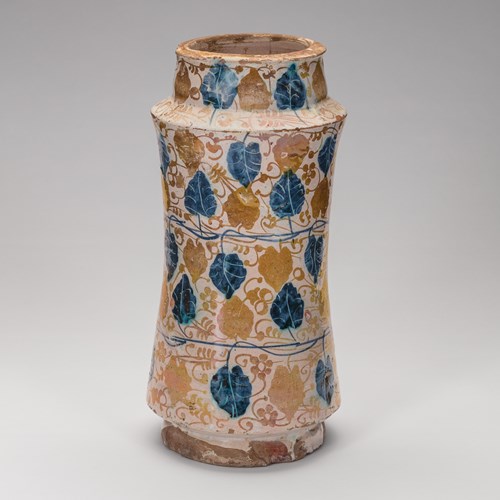Marketplace
Copper-Lustre Hispano-Moresque Albarello
The albarello developed in the Middle East as a pharmacy jar. Their waisted form allowed them to be taken off a shelf easily, and the narrowed rim allowed for parchment or leather to be tied over the jar with cord. Throughout the 13th and 14th centuries, albarellos were exported in large quantities from Persia, Syria and Egypt to Europe, resulting in their production in Spain and Italy.
This large, monochrome example was made in Manises, Spain. It is made of fritware, decorated with metallic lustre glaze, the reddish-brown hue of which indicates a high copper content. In the 15th and 16th centuries, the heyday of the Valencian ceramics industry, glazes tended towards yellow and gold due to a liberal use of silver. As the ceramics industry declined in the 17th and 18th centuries, copper was substituted for gold in the glazes, producing the rich red colour of these pieces.1
The distinctive combination of cream tin glaze and copper lustre glaze can be seen on objects such as a 17th century barrelled jar in the Fitzwilliam Museum, Cambridge (accession no. C.3-1911) and a 17th century plate in the Metropolitan Museum of Art, New York (accession no. 91.1.118). Though marks on the body of this albarello indicate that it was touching another similarly-sized object as it was fired, perhaps its pair, this is the only known example of a monochromic copper-lustre albarello.
n.b. accession nos are clickable links
1 Tolar, Tanja. ‘Spanish Lustre Dish’, Illuminating Objects. Retrieved online at https://sites.courtauld.ac.uk/illuminating-objects/illuminating-objects-home/spanish-lustre-dish/ on 14/05/2024.
More artworks from the Gallery







_T638772026628488441.jpg?width=500&height=500&mode=pad&scale=both&qlt=90&format=jpg)
 Untitled 1_T638206163537998306.jpg?width=500&height=500&mode=pad&scale=both&qlt=90&format=jpg)
